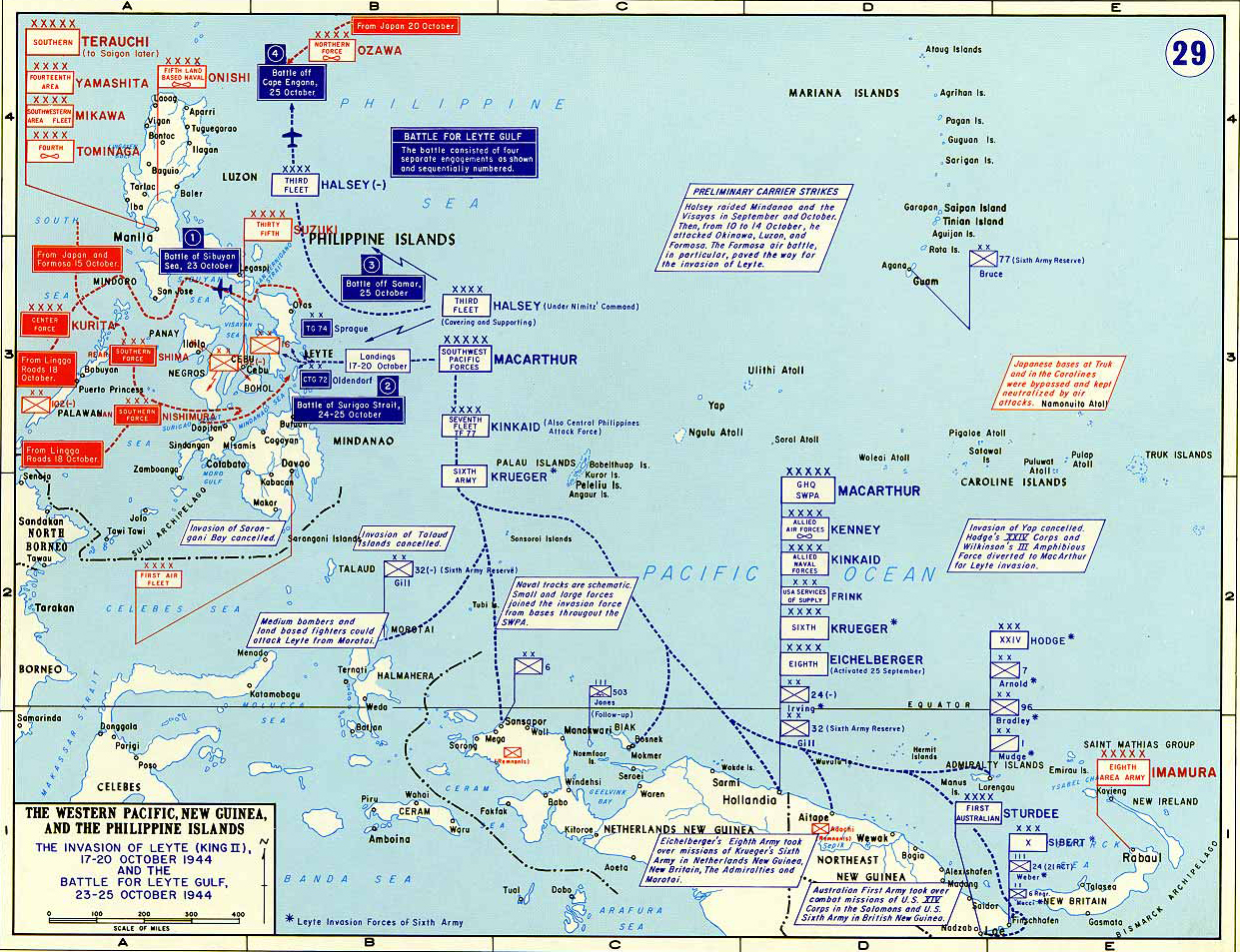Map Description
History Map of WWII:
The Western Pacific, New Guinea, and the Philippine Islands 1944
Illustrating:
The Invasion of Leyte (King II): 17-20 October 1944
The Battle of Leyte Gulf: 23-26 October 1944
The Invasion of Leyte (Operation King II), launched on 17 October 1944, marked General Douglas MacArthur’s return to the Philippines.
Advance forces (underwater demolition teams and reconnaissance units) began operations on 17 October, and the main
amphibious landings occurred on 20 October 1944, which is often cited as the formal return of MacArthur.
U.S. Sixth Army forces under General Walter Krueger landed on Leyte’s eastern coast at Tacloban and Dulag beaches,
aiming to secure airfields and disrupt
Japanese supply routes between the Philippines and resource-rich Southeast Asia.
The Japanese, recognizing the threat, mobilized naval and air forces to counter the invasion, which was their Operation Shō-Gō 1,
a complex naval counterattack involving three main forces. This was setting the stage for
the Battle of Leyte Gulf (23–26 October 1944), the largest naval battle in history,
by tonnage of ships involved and scope of operations.
The Battle of Leyte Gulf comprised four major engagements:
-
Battle of Sibuyan Sea (24 October [not 23 October]):
Multiple waves of U.S. carrier aircraft crippled the Japanese Center Force, sinking the battleship Musashi. This weakened Admiral Kurita’s fleet, who temporarily retreated, but failed to halt its advance toward Leyte.
-
Battle of Surigao Strait (24–25 October):
U.S. and Australian forces under Admiral Jesse Oldendorf executed a classic “crossing the T” maneuver, decimating the Japanese Southern Force. This marked the last battleship-versus-battleship engagement in naval history.
-
Battle off Samar (25 October):
A smaller U.S. escort carrier group faced Kurita’s remaining fleet. Despite being outgunned, U.S. destroyers and aircraft launched aggressive attacks, forcing Kurita to retreat - a decision later criticized as a strategic blunder. Kurita withdrew despite overwhelming firepower, fearing he had stumbled into a larger U.S. force.
-
Battle of Cape Engaño (25 October):
U.S. forces neutralized the Japanese Northern Force under Vice Admiral Jisaburō Ozawa, a decoy fleet of carriers with minimal aircraft, effectively ending Japan’s carrier-based threat.
Following the Leyte operations, General Robert Eichelberger’s Eighth Army assumed control of Krueger’s Sixth Army
responsibilities in Netherlands New Guinea, New Britain, the Admiralties, and Morotai by late 1944, allowing Sixth Army
to focus on the Philippines.
Concurrently, the Australian First Army relieved U.S. XIV Corps in the Solomons and U.S. Sixth Army in British New
Guinea, reflecting Allied efforts to reallocate resources for the Philippines campaign and eventual advances toward Japan.
The Leyte campaign crippled Japanese naval power and established a critical foothold in the Philippines, though
prolonged ground fighting continued until December 1944.
Strategic missteps by Japanese commanders, combined with Allied air and naval superiority, ensured a decisive
shift in the Pacific Theater.
Credits
Courtesy of the United States Military Academy Department of History.
Related Links
About the Second World WarWWII Timelines

